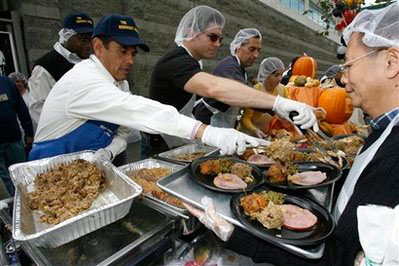CHICAGO – The line for a Thanksgiving meal was long when the Chicago Christian Industrial League shelter opened Thursday morning, and volunteers served more than 200 people in the first 40 minutes — record demand for the shelter.
Among the hungry were familiar faces, people who had eaten their last Thanksgiving meal at the shelter and others who had helped provide those meals, said executive director Mary Shaver.
"These are the people who are always giving money — and now they're asking for help," Shaver said. "These were the people donating money to us."
As millions of American families gathered to give thanks for what they have, food banks and shelters across the country struggled to cope with a spike in demand for their services. With more people feeling the weight of the economic downturn, those who oversee the charities say they are seeing many new faces on food lines.
"Food bank after food bank tells me it's new faces, people they haven't seen before," said Ross Fraser, spokesman for Feed America, a Chicago-based charity that coordinates corporate donations to more than 200 U.S. food banks. "They will tell you it's the worst it's ever been."
"Starting about a year ago, we've seen a very significant spike in the demand," Fraser said. "It used to be the poorest of the poor who came to us for help." But higher food prices are affecting the working poor "and the needle is moving up in terms of the income we're starting to serve," he said.
The Greater Chicago Food Depository, the city's food bank, has seen a 33 percent increase in food pantry demand from July to September of 2008, compared to the same period last year, said spokesman Bob Dolgan.
"Our network is strained right now," Dolgan said. "Our most successful pantries ... are having to turn people away."
Donations to the Salvation Army in the Washington, D.C., area have dropped 20 percent, while the agency grapples with a 30 percent increase in requests for assistance, said Maj. Steve Morris, the organization's area commander.
The Capital Area Food Bank, Washington's primary distribution center for food agencies, said calls from needy residents have jumped nearly 250 percent in the past six months. But cash donations are down about 10 percent from last fall, and food contributions have declined 15 percent.
The Food Bank of Alaska in Anchorage dipped into its Christmas reserves to make sure everyone seeking Thanksgiving Day donations received them. The food bank handed out turkey dinners Monday to 5,787 people at eight sites, about one-third more than last year's 4,237.
"I'm not worried about the Christmas stock today," said Susannah Morgan, the food bank's executive director. "That's a problem for Monday. What's important is that we didn't turn anybody away."
Restaurateur Francisco Garcia, who hosts an annual dinner for locals in Anaheim, Calif., said he expected to feed as many as 15,000 people on Thursday without any trouble and hoped to give leftovers to the homeless and elderly.
But he said fundraising for the event was more challenging this year as donors, hard-hit by the economic downturn and job losses, scaled back their contributions.
"Everybody is giving about half or a quarter of what they did before," said Garcia, who has compensated by seeking in-kind donations and using money from his restaurant.
At the Fred Jordan Mission in downtown Los Angeles, organizers expected to feed between 2,000 and 3,000 families Thursday. Since the year began, the number of people seeking food or transitional housing has jumped at least 15 percent, said Tom Jordan, executive vice president of the Mission.
"With the state of the nation, the way the economy is, so many people are scrambling just to stay afloat," Jordan said.
Jeremy Reynalds, chief executive of Joy Junction shelter in Albuquerque, N.M., said the troubled economy has doubled the number of residents seeking shelter, while average donations have been cut in half.
"We're working twice as hard to get more donors, who are giving less. The average Joe doesn't have any disposable income to give. The word that's going around for 2009 is to target your richer or more well-off donors because the others don't have a penny to give," Reynalds said.
Associated Press writers Carla K. Johnson and Karen Hawkins in Chicago, Amy Taxin in Los Angeles, Brett Zongker in Washington, Heather Clark in Albuquerque, N.M., and Steve Quinn in Juneau, Alaska, contributed to this report.
Copyright 2008 Associated Press. All rights reserved. This material may not be published, broadcast, rewritten, or redistributed.

















